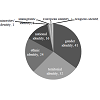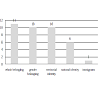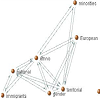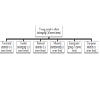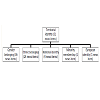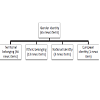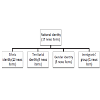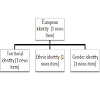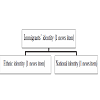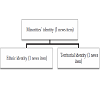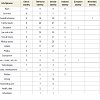Journal of Neurology and Psychology
Download PDF
Special Issue: Social Psychology
Research Article
*Address for Correspondence: Stanislava Stoyanova, PhD, Professor of Psychological Measurements, Department of Psychology, Faculty of Philosophy, South-West University “Neofit Rilski", Blagoevgrad, Bulgaria, E-mail: avka@abv.bg
Citation: Stoyanova S. Media Representation of Young People’s Identity in Bulgaria. J Neurol Psychol. 2014; S(1): 7.
Copyright © 2014 Stoyanova S. This is an open access article distributed under the Creative Commons Attribution License, which permits unrestricted use, distribution, and reproduction in any medium, provided the original work is properly cited.
Journal of Neurology and Psychology | ISSN: 2332-3469 | Special Issue: 1
Submission: 22 May 2014 | Accepted: 06 June 2014 | Published: 11 June 2014
Editors: Dr. Cecilia Cheng, Department of Psychology, University of Hong Kong, ChinaDr. Yiqun Gan, Professor of Psychology, Peking University, China
Ethnic, gender and territorial identities were in the core of media representations of young people’s identity not only as frequently depicted by different sources in society, but also as revealed by youth opinions presented in media.
Territorial identity also was connected with a lot of the other kinds of identities – 5 (Figure 3). The news items dealing with young people’s territorial identity (as residents - N=51) presented also their gender belonging, ethnic belonging, national identity, minority membership, and European identity. There was not any news item presenting territorial identity that related it to religious identity and to immigrants (Figure 5).
Territorial identity also was in the core of social representations of young people’s identity reflected by the chosen media, because territorial identity met the both criteria of connectivity and frequency.
The news items dealing with young people’s national identity (N=17) presented also their ethnic identity, territorial identity, gender identity, and immigrants’ group. There was not any news item presenting national identity that related it to religious identity, tominority groups, and to European identity (Figure 7).
However, only gender identity was in the core of social representations of young people’s identity reflected by the chosen media, because gender identity met the both criteria of connectivity and frequency, while national identity met only the criterion of connectivity and national identity was in not extreme periphery of media representations of young people’s identity. This structure of media representation of young people’s identity was confirmed by the finding that frequency of presenting young people’s national identity and gender identity by the chosen media differed significantly (χ2McNemar Test=25.962; p<0.001).
The different kinds of young people’s identities were related to a lot of spheres of social life. The young people’s identitites in the core of the media representations were related to more life spheres than the peripheral young people’s identities (Table 1).
Research Article
Media Representation of Young People’s Identity in Bulgaria
Stanislava Stoyanova*
- Department of Psychology, Faculty of Philosophy, South-West University “Neo it Rilski", Blagoevgrad, Bulgaria
*Address for Correspondence: Stanislava Stoyanova, PhD, Professor of Psychological Measurements, Department of Psychology, Faculty of Philosophy, South-West University “Neofit Rilski", Blagoevgrad, Bulgaria, E-mail: avka@abv.bg
Citation: Stoyanova S. Media Representation of Young People’s Identity in Bulgaria. J Neurol Psychol. 2014; S(1): 7.
Copyright © 2014 Stoyanova S. This is an open access article distributed under the Creative Commons Attribution License, which permits unrestricted use, distribution, and reproduction in any medium, provided the original work is properly cited.
Journal of Neurology and Psychology | ISSN: 2332-3469 | Special Issue: 1
Submission: 22 May 2014 | Accepted: 06 June 2014 | Published: 11 June 2014
Editors: Dr. Cecilia Cheng, Department of Psychology, University of Hong Kong, ChinaDr. Yiqun Gan, Professor of Psychology, Peking University, China
Abstract
The aim of this study was to describe print media representations of young people’s identity in Bulgaria. A content analysis of September 2010 issues of two print Bulgarian daily newspapers [1,2] was carried out. The content analysis matrix was prepared by an international group of researchers during the summer school “Social cognition” organized by EFPSA and held in Blagoevgrad, Bulgaria in July 2010. This content analysis matrix was created to study media representations of the age group from 13 to 25. A total number of 159 articles dedicated to young people (36 in “Sega” and 123 in “Telegraph”) were coded. The topic of young people’s identity was studied in the form of ethnic and national identity versus minorities and immigrants’ identity, religious identity, identity related to gender, and territorial identity. The most salient young people’s identity represented by the chosen media was related to gender (in 65 news items), next one was territorial identity (in 51 news items), third one was ethnic identity (in 38 news items), then national identity (in 25 news items), then minorities and immigrants’ identity (in 2 news items), and religious identity was presented in 1 media publication for the indicated time period.Introduction
What is identity?Identity means the image of oneself as possessing some durable and stable traits [3]. Identity is consistent and continuous [4]. The term identity refers also to social roles [5,6]. As an individual learns the rules of behavior of a group, s/he identifies himself/herself as a member of the social group [7].
The essential criterion for group membership is the criterion of identity – the individuals concerned themselves and are defined by others as members of a group [8]. The social identity is a part of the individual self-concept, which arises as a result from self-knowledge of belonging to a social group, and from the emotional and evaluative meaning of this membership [9]. Group members differentiate ingroup members from out-group members and demonstrate in-group favoritism [10,11].
How identity is formed
Identification is a process of identity development resulting in similarity between self and other. With identification, characteristics and desires of another person are adopted as one’s own [12]. Identity is created by means of the sense of belonging to a group. The individual compares oneself to the other people and establishes the similarities with the in-group and the differences with the out-groups [13].
Differentiation as a process of identity development operates via comparison of self and others. Differentiation involves developing or accentuating qualities and desires that are different from the perceived qualities of another person, and suppressing qualities that are perceived as similar [12].
E. Erikson’s theory defines the age from 12-13 to 20 years old as Identity vs. Diffusion of Identity [14]. Successful resolution of this stage results in a young person with a strong and stable sense of who s/he is. Failure produces an unclear sense of identity.
J. Marcia has written about four different statuses of identity - achievement, moratorium, foreclosure, and diffusion. Identity achieved occurs after the teen has explored options and has committed to a set of values or goals. A teen or young adult who is still experimenting without any commitments is in a moratorium. One who commits to a set of values without exploration has reached foreclosure. Diffused individuals are neither exploring nor committed to any identity [15-17].
Different kinds of identities
The literature review described different kinds of identity - personal identity [4,11,18], social identity [18], collective identity [4,6,18], global (planetary) identity [4], religious identity [19,20], etc.
Social identity refers to self-descriptions that emerge from social group memberships. Personal identity relates to the individual qualities that make a person unique and different from other ingroup members [21].
Ethnic identity includes self-categorization as a representative of an ethnic group, sense of belonging to the ethnic group, pride of belonging to the ethnic group, attitudes towards the ethnic in-group and the ethnic out-groups, the interest in the culture, history and the traditions of the ethnic in-group, the wish for having friends and conjugal partner from the ethnic in-group, and inclusion, participation in the ethnic customs and activities [18,22-25]. Collective identity puts the emphasis on the shared group activities [6,18].
Cultural identity is broader than ethnic identity. Cultural identity with a specific group can include people from many different ethnic backgrounds. Whereas youth living within the same nation may have different cultures, youth of different ethnicities may actually share similar cultural values [26].
National identity is a sense of belonging and affiliation to a nation or state, the personal importance of this state/nation compared to the other states/nations, satisfaction to be a member of this nation [18].
Territorial (local) identity is related to the city/town/village of residence [18]. Gender identity is the sense of masculinity or femininity [18].
People belong to multiple social groups. Multiple identities coexist within any individual [4]. Identities vary in importance (salience or centrality) to a person. Having many versus few identities leads to greater psychological well-being if the identities are highly important and in harmony with each other, because they provide resources. Having many versus few identities leads to lower psychological wellbeing if the identities are highly important and in conflict with each other, because they provoke incompatible behaviors. When identities are less important, neither the number of identities nor identity harmony should affect well-being [5].
Social representations of identity and media influence
Individuals possess different identity standards that represent what it means to be a member of a group, an occupant of a role. Society gives form to each identity giving it a name and proscribing the appropriate behaviour for it [7].
Social representations are communicated bodies of knowledge that are shared among members of society [27]. Media create, change and distribute some social representations [28]. Media are a powerful influence in the development of cultural identity in youth [26]. Media send a lot of messages of what it means to be a man or a woman, and they disseminate traditional gender roles [29,30]. Youth look to media for information about their own sexual identity and sexual behaviors [29].
Adolescents’ use of media as sources of information regarding ethnicity may be particularly significant for those who have limited real-life exposure to peers of different ethnicities [29]. The frequent portrayal of minorities as victims or in violent roles on television may encourage intolerance and fear [29].
Social representations have some central components, a core that is very stable (shared by a lot of individuals) and peripheral components that could be more easily changed [31,32].
One criterion for the core elements of a social representation is that central elements are more frequently present in the discourse concerning the object than the peripheral elements are – either the extreme periphery or not extreme periphery [32,33]. The central elements are associated with a larger number of elements than the periphery ones [33]. More central parts of social representations are more connected.
Hypothesis
As group members typically use the salient features of their social identities to categorize one another, and because racioethnicity and gender are highly salient and accessible [11], the hypothesis was that media representations’ of young people identity would reflect their multiple identities, especially gender identity and ethnic identity.Method
The method of extraction/measurement of media representations of young people’s identity was the central nucleus research using content analysis [33].
A content analysis matrix was prepared on the basis of the content analysis matrices and results from previous studies [34-37] by a group of 7 psychologists during the European Summer School “Social Cognition” held in Blagoevgrad, Bulgaria in July 2010, organized by the European Federation of Psychology Students’ Associations, and the Association of Young Psychologists In Bulgaria “4th April” in the campus of South-West University “Neofit Rilski” [38]. One of them was an Associate Professor and PhD holder. The others had Bachelor (N=4) or Master (N=2) degrees in psychology. During the initial coding training, all seven of them carried out the same codings. Intercoder agreement about chosing the news items to be coded was 81%. The average percent of intercoder agreement for the wholce coding matrix (how the content to be coded) was 85%. This content analysis matrix was created to study media representations of the age group from 13 to 25 years old. After the initial training, each coder conducted part of the data only.
A content analysis of September 2010 issues of two print Bulgarian daily newspapers [1,2] was carried out. A total of 159 articles dedicated to young people (36 in “Sega” and 123 in “Telegraph”) were coded according to key topics like the focus of the article (22 foci were enumerated and among them were family issues, medical issues, politics, culture, religion, etc.), the source of the material cited, and the labels used by media when referring to young people (ethnic belonging, religious belonging, citizenship, gender belonging, residents, etc). The author examined whether any particular topics concerning different kinds of identity were frequently mentioned that indicated salience of media representation.
Results
The young people were depicted by the newspapers as members of gender groups in 65 news items. Territorial identity of young people - as residents was pointed out in 51 news items. Ethnic identity of young people was pointed out in 38 news items. The young people were depicted by the newspapers as nationals of a country (in 25 news items), i.e. Bulgarian citizens (in 17 news items or 10.7%) and foreigners (in 8 news items or 5%); as minorities (in 1 news item); as immigrants (in 1 news item); as European citizens (in 1 news item); as members of a religious group (in 1 news item) (Figure 1).When the quoted sources were young people (in 31 news items), they expressed mainly their ethnic belonging, their gender and territorial identity, then their nationality, then being immigrants, never their religious belonging, never their minority belonging, never their European identity (Figure 2).
Ethnic identity was connected with the biggest number of the other kinds of identities – 6 (Figure 3). The media articles dealing with young people’s ethnic belonging (N=38) mentioned also their territorial identity, gender belonging, national identity, minority membership, immigrants’ group, and European identity. There was not any news item presenting ethnic identity that related it to religious identity (Figure 4). Ethnic identity was in the core of social representations of young people’s identity reflected by the chosen media, because ethnic identity met the both criteria of connectivity and frequency.
Territorial identity also was connected with a lot of the other kinds of identities – 5 (Figure 3). The news items dealing with young people’s territorial identity (as residents - N=51) presented also their gender belonging, ethnic belonging, national identity, minority membership, and European identity. There was not any news item presenting territorial identity that related it to religious identity and to immigrants (Figure 5).
Territorial identity also was in the core of social representations of young people’s identity reflected by the chosen media, because territorial identity met the both criteria of connectivity and frequency.
Frequency of presenting young people’s ethnic identity and territorial identity by the chosen media did not differ significantly (χ2McNemar Test=2.361; p=0.124) and they both formed the core of media representations of young people’s identity. Frequency of presenting young people’s ethnic identity and gender identity by the chosen media differed significantly (χ2McNemar Test=8.779; p=0.003), but frequency of presenting young people’s gender identity and territorial identity by the chosen media did not differ significantly (χ2McNemar Test=3.841; p=0.05), so gender identity was also a stable element in the core of media representations of young people’s identity.
Gender identity and national identity were both connected with the same number of the other kinds of identities – 4 (Figure 3). The news items dealing with young people’s gender identity (N=65) presented also their territorial belonging, ethnic belonging, national identity, and European identity. There was not any news item presenting gender identity that related it to religious identity, to immigrants, and to minority groups (Figure 6).
The news items dealing with young people’s national identity (N=17) presented also their ethnic identity, territorial identity, gender identity, and immigrants’ group. There was not any news item presenting national identity that related it to religious identity, tominority groups, and to European identity (Figure 7).
However, only gender identity was in the core of social representations of young people’s identity reflected by the chosen media, because gender identity met the both criteria of connectivity and frequency, while national identity met only the criterion of connectivity and national identity was in not extreme periphery of media representations of young people’s identity. This structure of media representation of young people’s identity was confirmed by the finding that frequency of presenting young people’s national identity and gender identity by the chosen media differed significantly (χ2McNemar Test=25.962; p<0.001).
Frequency of presenting young people’s national identity and European identity by the chosen media differed significantly (p < 0.001), so national identity was not in the extreme periphery of media representations of young people’s identity, while European identity was in the extreme periphery of media representations ofyoung people’s identity.
Frequency of presenting young people’s European identity and immigrants’ identity, immigrants’ identity and minorities’ identity, minorities’ identity and religious identity by the chosen media did not differ significantly (p=1) and they all formed the extreme periphery of media representations of young people’s identity.
The extreme periphery of social representations of young people’s identity reflected by the chosen media included European identity (connected with 3 out of the other kinds of identities) (Figure 8), immigrants’ identity (connected with 2 out of the other kinds of identities) (Figure 9), minorities’ identity (connected with 2 out of the other kinds of identities) (Figure 10), and religious identity (not connected with any other kind of identities). European, immigrants’, minorities’ and religious identities did not meet the both criteria of connectivity and frequency in order to be central elements of social representations.
The different kinds of young people’s identities were related to a lot of spheres of social life. The young people’s identitites in the core of the media representations were related to more life spheres than the peripheral young people’s identities (Table 1).
Social perception and social representations consider high presence of aggression and violence in media [39]. The literature review showed controversial findings about immigrants andcriminality. Immigrants tend to settle in neighborhoods that are poor, culturally heterogeneous, and with high crime rates. Recent immigrants are typically found to be less involved in violence than are natives [40]. Such a tendency was also revealed by the data in (Table 1).
Discussion
Ethnic identity, territorial identity and gender identity were in the core of media representations of young people’s identity reflected by the chosen media, their stable elements. The periphery of media representations of young people’s identity included national identity (not extreme periphery), European identity, immigrants’ identity, minorities’ identity, and religious identity (the extreme periphery). Some findings from several other studies on Bulgarian identity support to some extent this structure of media representations ofyoung people’s identity.In 2009, a study of identities of the Bulgarians living in Bulgaria at the age group 26-30 years old used the rank method and the results indicated that national identity dominated, gender identity was defined as second of importance, then territorial identity, then European identity, then ethnic identity, and at last place - religious identity. The Bulgarians living abroad at the age group 26-30 years old ranked at first place national identity, then gender identity, then European identity, then religious identity, then ethnic identity and at last place – territorial identity [18]. In 2006, Bulgarian ethnic identity of the age group from 20 to 33 years old was strongly expressed [41]. European identity was not yet any part of the Bulgarian respondents’ identity in December 2006. European identity unified the friends to find more common things between them when they had different ethnic identities [13]. Territorial identity was related to ethnic identity, but the connection between them was weak [13]. According to Moser and Lidvan, a person feels comfortable if the quarter he/she is living in is a bigger one, if he/she likes the population of this quarter, if he/she frequently meets the other people living in this quarter, if he/she has some friends living in this quarter and if he/she has a strongly expressed territorial identity [42].
In 2005, another study among Bulgarian children from 6 to 15 years old indicated that their gender identity was of first importance for them, then – their national and ethnic identity, then their age group identity, then territorial identity, and at last place of importance - European identity [43]. In 2000, the national identity was more important for the studied Bulgarians than religious identity was [44].
So, gender identity has been very stable element of Bulgarian’s youth identity for a long time period, while territorial and ethnic identities were not such stable elements. The specificity of media representations of young people’s identity in Bulgaria concerned less importance given to national identity compared to the use of some self-report questionnaires measuring identities.
These findings concerning media representations of young people’s identity are important, because they indicate what image of youth is imposed in the society by the media. This image not only reflects youth identity, but it influences reciprocically on the young people’s identity formation for the next generations pointing out different identities and relating them to some spheres of social life. A more detailed image of young people’s identities that connects the identity to a lot of life spheres is probably more exact. The one-sided representation of youth identities in few spheres of social life might be more incorrect.
These findings also reveal which kinds of young people’s identity are more difficult to be changed – this is the central part of the media representation of youth identity. It is useful such studies to be conducted systematically to reveal the trends in social representations of young people’s identity. The future studies should strive to avoid the limitations of this study that are the chosen only two Bulgarian media and only newspapers, and only for a month. A long-term study of TV and radio media could reveal further information on this topic.
References
- (2010) Newspaper “Sega”.
- (2010) Newspaper “Telegraph”.
- Cuéllar I, Nyberg B, Maldonado RE, Roberts RE (1997) Ethnic Identity and Acculturation in a Young Adult Mexicanorigin Population. Journal of Community Psychology 25: 535-549.
- Fiorelli FDG (2007) The psychosocial identity and the planetary identity. Erik H. Erikson and the study di ego, self and identity. Paper presented at 10th European Congress of Psychology (Prague, 2007 July 3th - 6th) Oral Session, 5 July 2007.
- Brook AT, Garcia J, Fleming MA (2008) The Effects of Multiple Identities on Psychological Well-Being. Per Soc Psychol Bull 34: 1588-1600.
- Baugnet L (1998) L’identité sociale. Paris: Dunod
- Kast C (2008) Social identity similarity effects on interpersonal evaluation. Curr Res Soc Psychol 14: 63-74.
- Turner D (1990) Social identification and psychological group formation. In: Todorova, E. (Ed.), Group and personality in social psychology: 14 Western-European scientists. Sofia: Science and Art 65-87.
- Tajfel H (1974) Social identity and intergroup behavior. Social Science Information 13: 65-93.
- Schneider SK, Northcraft GB (1999) Three social dilemmas of workforce diversity in organizations: a social identity perspective. Human Relations 52: 1445-1467.
- Martins LL, Milliken FJ, Wiesenfeld BM, Salgado SR (2003) Racioethnic diversity and group members’ experiences: the role of the racioethnic diversity of the organizational context. Group & Organization Management 28: 75-106.
- Vivona JM (2007) Sibling differentiation, identity development, and the lateral dimension of psychic life. J Am Psychoanal Assoc 55: 1191-1215.
- Stoyanova SY (2008) Factors influencing the choice of friends - analysis of Bulgarian friendship networks. Portularia 8: 93-109.
- Erikson EH (1968) Identity: youth and crisis. New York: W. W. Norton
- Årseth AK, Kroger J, Martinussen M, Marcia JE (2009) Meta-analytic studies of identity status and the relational issues of attachment and intimacy. Identity 9: 1-32.
- Scheibe KE (2005) Identity. Encyclopedia of Human Development. SAGE Publications, Inc.
- Sclafani JD (2005) Psychosocial development. Encyclopedia of Human Development. SAGE Publications, Inc.
- Ganeva Z (2010) Social identities and psychological well-being. Sofia: Valdex LTD, in Bulgarian
- Bader V (2003) Religious diversity and democratic institutional pluralism. Political Theory 31: 265-294.
- Bouma G, Singleton A (2004) A comparative study of the successful management of religious diversity: Melbourne and Hong Kong. International Sociology 19: 5-24.
- Reynolds KJ, Eggins RA, Haslam SA (2010) Uncovering diverse identities in organisations: AIRing versus auditing approaches to diversity management. Asia Pacific Journal of Human Resources 48: 45-57.
- Valk A, Karu K (2001) Ethnic attitudes in relation to ethnic pride and ethnic differentiation. J Soc Psychol 141: 583-601.
- Phinney J (1992) The Multigroup Ethnic Identity Measure: A new scale for use with adolescents and youth adults from diverse groups. Journal of Adolescent Research 7: 156-176.
- Verkuyten M (2002) Ethnic attitudes among minority and majority children: the role of ethnic identification, peer group victimization and parents. Social Development 11: 558-270.
- Verkuyten M (2003) Ethnic in-group bias among minority and majority early adolescents: The perception of negative peer behaviour. Br J Dev Psychol 21: 543-564.
- Johnson JL (2007) Cultural identity. Encyclopedia of Children, Adolescents, and the Media. SAGE Publications, Inc.
- McGuire WJ (1986) The vicissitudes of attitudes and similar representational constructs in twentieth century psychology. Eur J Soc Psychol 16: 89-130.
- Moscovici S, Markova I (2000) Ideas and their development: A dialogue between Serge Moscovici and Ivana Markova. In G. Duveen & S. Moscovici (Eds.), Social Representations. Explorations in Social Psychology (pp. 224-286). Cambridge: Polity.
- Padilla-Walker LM (2007) Adolescents, developmental needs of, and media. Encyclopedia of Children, Adolescents, and the Media. SAGE Publications, Inc.
- Hust SJT (2007) Gender identity development. Encyclopedia of Children, Adolescents, and the Media. SAGE Publications, Inc.
- Moliner P, Tafani E (1997) Attitudes and social representations: a theoretical and experimental approach. Eur J Soc Psychol 27: 687-702.
- Pereira de Sà C (1995) The central nucleus approach to social representations. UERJ, Rio de Janeiro p. 1-12.
- Jung Y, Pawlowski SD, Wiley-Patton S (2009) Conducting social cognition research in IS: A methodology for eliciting and analyzing social representations. Communications of the Association for Information Systems 24: 597-614.
- Anglin L, Johnson S, Giesbrecht N, Greenfield T (2000) Alcohol policy content analysis: a comparison of public health and alcohol industry trade newsletters. Drug and Alcohol Review 19: 203-212.
- Lampman C, Rolfe-Maloney B, David EJ, Yan M, McDermott N, et al. (2002) Messages about sex in the workplace: A content analysis of primetime television. Sexuality and Culture 6: 3-21.
- Ward J (2005) An opportunity for engagement in cyberspace: Political youth web sites during the 2004 European Parliament election campaign. Information Polity 10: 233-246.
- Bolzan N (2003) Kids are like that! Community attitudes to young people. National Youth Affairs Research Scheme.
- Stoyanova S, Eylem O, Veskioja B, McDermott E, Bozhilov D, et al. (2010) Attitudes towards and social represenations of young people. In: Slavchov B, Lazarova E (Eds), “Social Cognition in Action”. Book with publications from the European Summer School "Social Cognition" 17th-24th July 2010, Blagoevgrad, Bulgaria. pp. 59-67.
- Zografova Y (2001) Bulgarian aggressiveness in the transitional period. Sofia: Professor Marin Drinov Academic Publishing House, in Bulgarian.
- Graif C, Sampson RJ (2009) Spatial heterogeneity in the effects of immigration and diversity on neighborhood homicide rates. Homicide Studies 13: 242-260.
- Stoyanova S (2007) Methods for study of interethnic contacts and attitudes. Blagoevgrad: Iranik-M, in Bulgarian.
- Moser G, Lidvan P (1992) Environnement et sentiment d’insécurité. En Bernard Y, Segaud M (Eds.), La ville inquiète. Paris: Editions de l’Espace Européen 53-66.
- Ganeva Z (2009) Development of ethnic stereotypes during childhood. Sofia: Valdex LTD, in Bulgarian
- Bosakov V (2000) Bulgarian Turks between the culture of neighbourhood and religious identity. Sofia: Lik, in Bulgarian.


